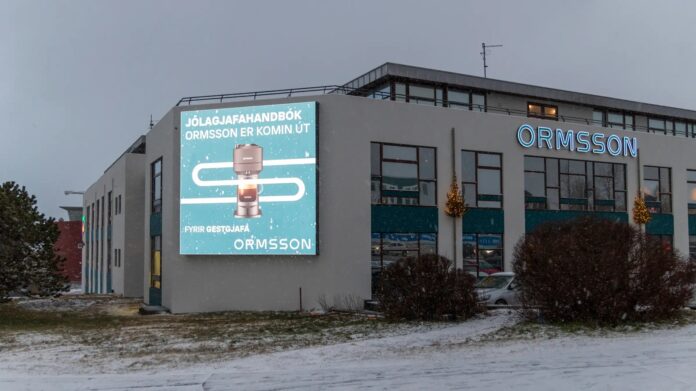Reykjavík City Council’s decision to deny Ormsson a building permit for a large illuminated sign at a road junction stands. Reykjavík District Court yesterday rejected the company’s request for the verdict to be quashed.
Reykjavík District Court yesterday rejected a request from the import and retail company Ormsson to annul Reykjavík City Council’s refusal to issue a building permit for a large illuminated sign on one wall of its premises.
The company had installed the sign where a mechanical poster board had previously been located and had begun displaying advertisements without obtaining a building permit. The city later decided to impose daily fines if the sign was not switched off and refused to grant the permit.
The company’s management did not accept this and appealed to the environmental and natural resources appeals board, which denied the company’s claim. The dispute then went to court, which ruled yesterday that the city and the appeals board had acted lawfully.
The illuminated sign faces the junction of Háaleitisbraut and Kringlumýrarbraut, where the company intended to promote its products and services to potential customers. Residents in the area complained about the size and brightness of the sign.
The judge said there was no doubt that the installation of an illuminated sign was subject to a building permit, but that the company had installed it and started displaying advertisements and promotional material without applying for one.
Ormsson had previously had a mechanical poster sign on the same wall. The ruling stated that this was about one-third the size of the new digital sign, and it could therefore be concluded that the two were not comparable. There were also such significant differences in the display capabilities of the mechanical sign, the fabric sign that replaced it, and the illuminated digital sign that it was highly questionable whether they could be considered similar.
The judge stated that whether the city’s or the company’s measurements were used, it was clear that the sign was closer to the Háaleitisbraut exit lane than permitted under the regulations. There were no substantive grounds for Ormsson’s claim that the exit lane should somehow be excluded when measuring the distance between the sign and the traffic structures.
The company argued that it was within its rights because the building inspector had approved its building permit application. This claim was based on an error in the subject line of an email that said the application had been approved, even though the body of the letter stated otherwise. Only a decision to postpone the imposition of daily fines had been made, which was corrected in a letter the following day.
The judge said this was an obvious error and that it should have been clear to the company’s management from the inconsistency between the subject line and the text that the application had not been approved. In addition, the error had been immediately corrected.
Ormsson’s claim that the city and/or the environmental and natural resources appeals board had violated written or unwritten procedural rules of administrative law and the Administrative Procedures Act was rejected. The judge also rejected the argument that it mattered whether other signs might also breach regulations or laws:
A wrong is not righted by pointing to another.
The judge also criticised the drafting of the company’s statement of claim, saying it was excessively long and contained considerable repetition. He said that because of this and other aspects of the document, the city’s defence had to be more extensive than necessary. However, this did not prevent a judgment from being delivered in the case.
Source: Ruv.is




